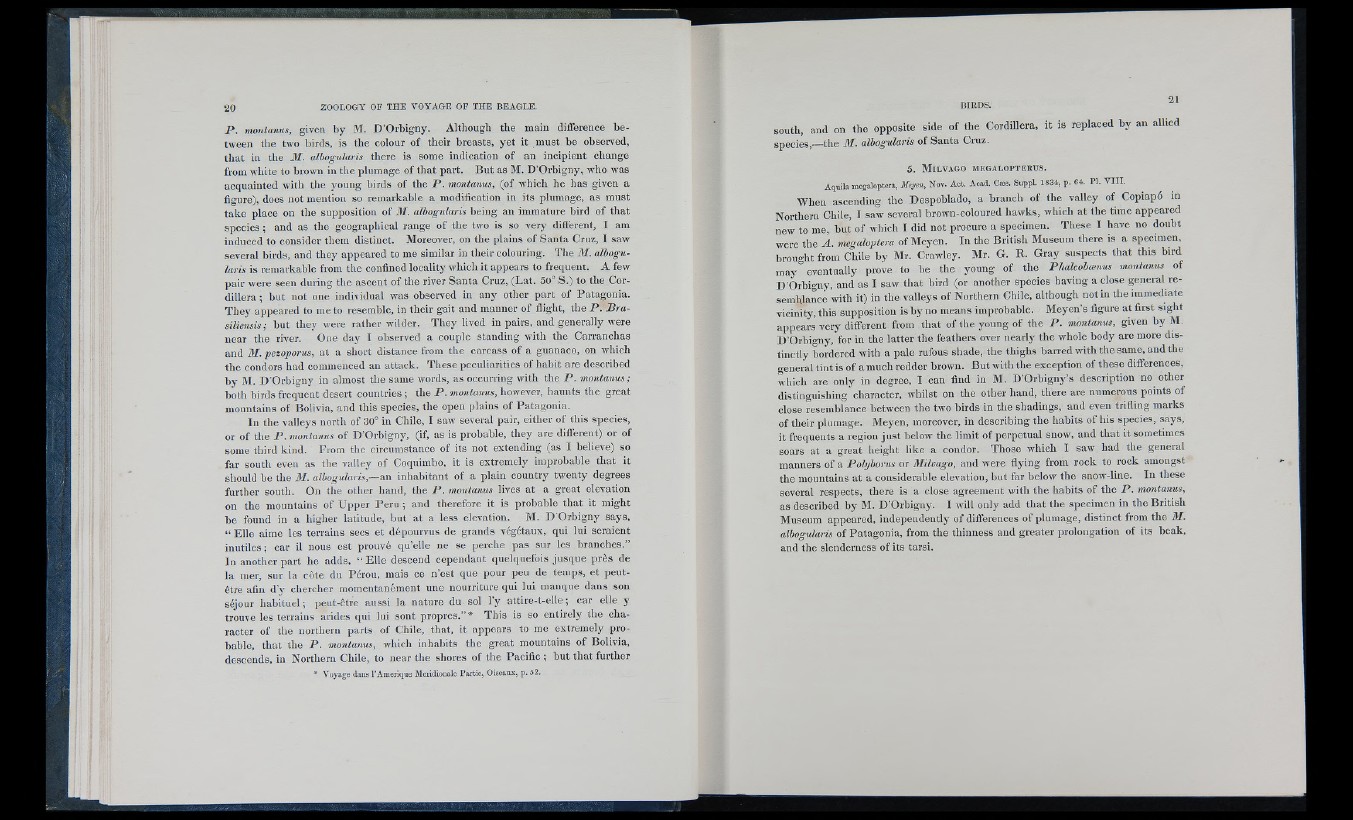
P . montaiMS, given by M. D'Orbigny. Although the main difference between
the two birds, is the colour of their breasts, yet it must be observed,
that in the 31. albogularis there is some indication of an incipient change
from white to brown in tlie plumage of that part. But as M. D’Orbigny, who was
acquainted with the young birds of the P . montanus, (of which he has given a
figure), does not mention so remarkable a modification in its plumage, as must
take place on the supposition of 31. albogularis being an immature bird of that
species ; and as the geographical range of the two is so very different, I am
induced to consider them distinct. Moreover, on the plains of Santa Cruz, I saw
several birds, and they appeared to me similar in their colouring. The 31. albogularis
is remarkable from the confined locality which it appears to frequent. A few
pair were seen during the ascent of the river Santa Cruz, (Lat. 50° S.) to the Cordillera
; but not one individual was observed in any other part of Patagonia.
They appeared to me to resemble, in their gait and manner of flight, the P . B r a siliensis;
but they were rather wilder. They lived in pairs, and generally were
near the river. One day I observed a couple standing with the Carranchas
and 31. pezoporus, at a short distance from the carcass of a guanaco, on which
the condors had commenced an attack. These peculiarities of habit are described
by M. D'Orbigny in almost the same words, as occurring with the P . montanus;
both birds frequent desert countries ; the P . montanus, however, haunts the great
mountains of Bolivia, and this species, the open plains of Patagonia.
In tlie valleys north of 30° in Chile, I saw several pair, either of this species,
or of the P . montayius of D ’Orbigny, (if, as is probable, they are different) or of
some third kind. From the circumstance of its not extending (as I believe) so
far south even as the valley of Coquimho, it is extremely improbable that it
should he the 31. albogularis,—an inhabitant of a plain country twenty degrees
further south. On the other hand, the P . montayius lives at a great elevation
on the mountains of Upper Peru ; and therefore it is probable that it might
be found in a higher latitude, but at a less elevation. M. D'Orbigny says,
“ Elle aime les terrains secs et dépourvus de grands végétaux, qui lui seraient
inutiles; car il nous est prouvé qu’elle ne se perche pas sur les branches.”
In another part he adds, “ Elle descend cependant quelquefois jusque près de
la mer, sur la côte du Pérou, mais ce n’est que pour peu de temps, et peut-
être afin d’y chercher momentanément une nourriture qui lui manque dans son
séjour habituel; peut-être aussi la nature du sol l’y attire-t-elle; car elle y
trouve les terrains arides qui lui sont propres.” * This is so entirely the character
of the northern parts of Chile, that, it appears to me extremely probable,
that the P . ynontayius, which inhabits the great mountains of Bolivia,
descends, in Northern Chile, to near the shores of the Pacific ; but that further
* Voyage dans I’Amerique Méridionale Partie, Oiseaux, p. 52.
south, and on the opposite side of the Cordillera, it is replaced by an allied
species,—the 31. albogularis of Santa Cruz.
5 . M il v a g o m e g a l o p t e k u s .
Aqtiila megaloptm, Meym, Nov. Act. Acad. Caes. Suppl. 1831, p. 61. PI. 'YIII.
'When ascending the Despoblado, a branch of the valley of Copiapô in
Northern Chile, I saw several brown-coloured hawks, which at the time appeared
new to me, but of which I did not procure a specimen. These I have no doubt
were the A. ynegaloptera of Meyen. In the British Museum there is a specimen,
brought from Chile by Mr. Crawley. Mr. G. R. Gray suspects that this bird
may” eventually prove to be the young of the Phalcobænus montayius of
D ’Orbigny, and as I saw that bird (or another species having a close general resemblance
with it) in the valleys of Northern Chile, although notin the immediate
vicinity, this supposition is by no means improbable. Meyen’s figure at first sight
appears very different from that of the young of the P . montanus, given by M.
D ’Orbigny, for in the latter the feathers over nearly the whole body are more distinctly
bordered with a pale rufous shade, the thighs barred with the same, and the
general tint is of a much redder brown. But with the exception of these differences,
which are only in degree, I can find in M. D’Orbigny’s description no other
distinguishing character, whilst on the other hand, there are numerous points of
close resemblance between the two birds in the shadings, and even trifling marks
of their plumage. Meyen, moreover, in describing the habits of his species, says,
it frequents a region just below the limit of perpetual snow, and that it sometimes
soars at a great height like a condor. Those wdiich I saw had the general
manners of a Polyborus or 3Iiloago, and were flying from rock to rock amongst
the mountains at a considerable elevation, but far below the snow-line. In these
several respects, there is a close agreement with the habits of the P . montayius,
as described by M. D ’Orbigny. I will only add that the specimen in the British
Museum appeared, independently of differences of plumage, distinct from the 31.
albogularis of Patagonia, from the thinness and greater prolongation of its beak,
and the slenderness of its tarsi.